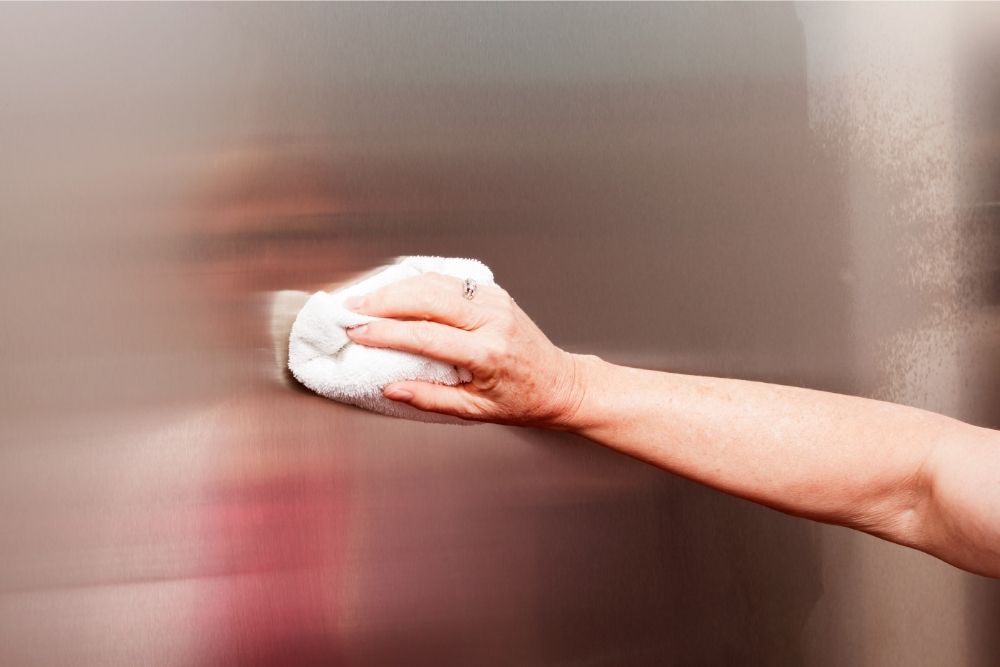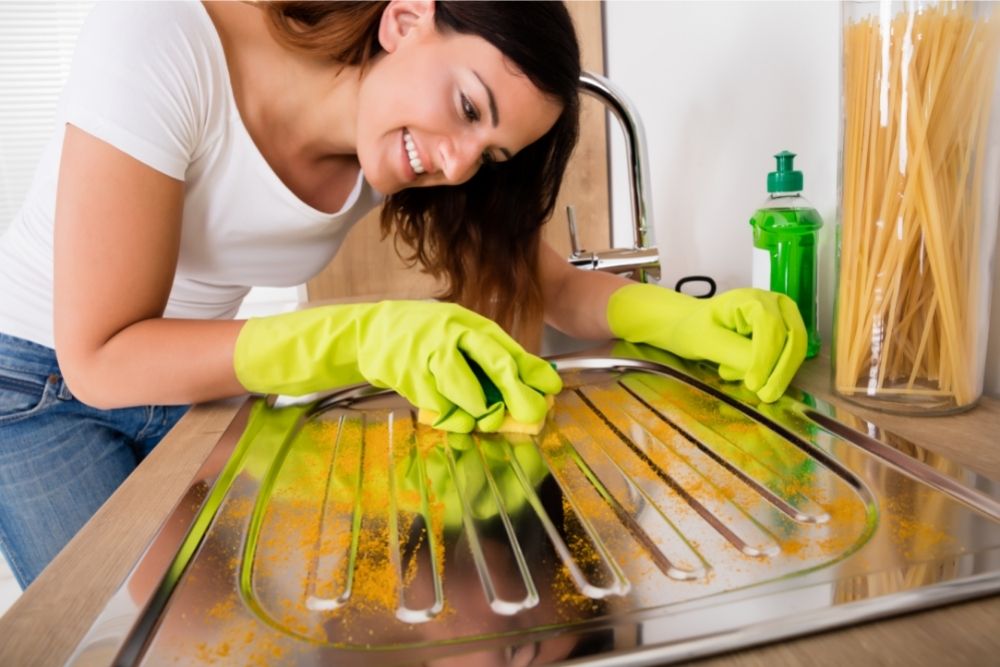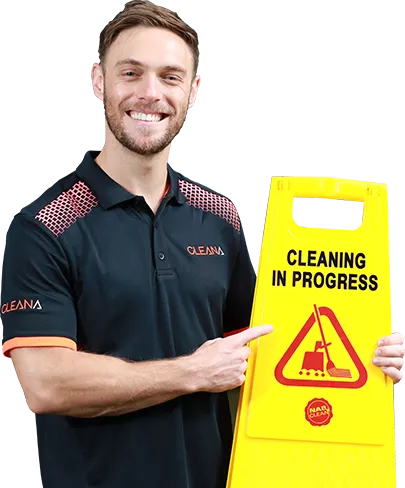Whilst stainless steel is known for its durability and long-lasting wear, everyone who owns anything made out of this material knows that it never looks quite spotless. This is especially true when it comes to the kitchen where food stains and knives are at large.
And then there is the bathroom: watermarks, fingerprints, and the humidity – the list is endless when it comes to things that may cause dirt on a stainless steel surface.
Whilst it is known for resisting something like rust, dust and dirt may be responsible for its potential to do so. This means that creating a good cleaning routine is the best answer to looking after your stainless steel appliances.
If stainless steel is left to its own devices, the material can start to show signs of corrosion, and aesthetically, it will not look appealing to the eye.
To avoid having to replace items, creating a good cleansing routine is one of the simplest ways to keep stainless steel appliances clean and rust-free. In this guide, our commercial cleaners reveal easy ways to clean stainless steel to keep it spotless and damage-free.
Things To Avoid
Looking after stainless steel is not complicated, though there are a number of do’s and don’ts when it comes to looking after it.
For instance, especially on a stainless steel sink, never let sponges, towels, bar soap, and anything made out of rubber sit on the surface. It can cause bacteria to form because moisture is trapped, and that is never a good sign!
If you use cast iron or stainless steel cookware, never let it sit in a stainless steel sink for a long time. This can actually cause rust from the moisture.
Never use anything made out of stainless steel as a cutting board, especially your sink. The material is easily damaged by knives and you will be able to see the cut marks that have been left behind. You cannot get rid of these indents without replacing the full appliances either, so just do not do it in the first place.
Now that is out of the way, let us look at how to keep stainless steel looking its best.
General Tips And Tricks
Keeping stainless steel surfaces dry is one of the best ways to avoid anything happening to it. Generally, it also just means that water spots will not be left behind either. Whilst this will not damage stainless steel, it just does not look nice.
Always using a dry, lint-free towel or cloth to wipe down the surfaces once they have been used is a simple way to keep stainless steel looking its best.
This is the same for sinks too. Drying a full sink will stop rust from forming, so keep that in mind the next time you wash the dishes – rinse and fully wipe down with a dry cloth.
If you are worried about not having a sparkling sink, then always wash away dish soap residue due to the chlorides in the product. These chemicals can actually affect the look of stainless steel. Again, it will not cause damage, but over time the sink will look dull and maybe even slightly stained.

How To Clean Stainless Steel?
If you put your fingers over stainless steel, you will be able to feel the grain. Whilst it is not detrimental to clean in the direction of the grain, it will help with the penetration of cleaning products. Not only that, it will add extra shine to the surface.
If you do want to clean in this way, then do keep in mind that any added knobs, for example, may present grain in a different direction.
It is also always best to use lint-free clothes so as to not leave any bits of fiber behind. Using paper towels is absolutely fine, just do not expect the surface to be fully lint-free.
Warm Water And Cloth
First, let us start with the basics. Warm water and cloth can generally accomplish so much when it comes to cleaning the house, and this is no different when it concerns stainless steel.
It is completely risk-free because there are no chemicals to potentially react with the stainless steel, and it makes a really good starting point if you do not want to try anything too harsh just yet.
Using a cloth that has been doused in warm water, wipe in the direction of the grain. Once you have finished, wipe all the wet areas with a dry cloth to avoid the water spots this may cause.
Club Soda
Just like water, club soda has its uses around the house too. Whilst normally drunk alongside some gin, it can also be used to make stainless steel shine.
Put some club soda into a spray bottle and use this to spritz directly onto the surface. As soon as it has been sprayed, wipe it away with a dry cloth in the direction of the grain.
This is a good method to not only add that extra shine but to clean the surface of dirt and fingerprints.
White Vinegar
Anyone who knows anything about cleaning the home will have likely heard about the many benefits white vinegar holds. Whilst usually used in stain removal, it is also good at general cleaning.
You can use white vinegar in two ways: in a spray bottle or on a cloth. Whichever you choose all depends on what suits you best, but both do the same job.
Spritz white vinegar directly onto the surface, or apply it onto the surface via a cloth, and then let it sit for a few minutes – but not too long. Once you feel it is ready, wipe it with a dry cloth in the direction of the grain.

Dish Soap
Another tried and tested method for cleaning the kitchen, and not just the dishes either. Dish soap is an easy yet effective way of cleaning stainless steel.
Run your clean cloth under running water and squeeze as much excess liquid as you can out of it. Once it has become damp rather than soaked, add some dish soap to a small area and use this to clean the surface in the direction of the grain.
Once you have finished, dry the surface with a clean and dry towel to avoid water streaks.
Commercial Cleaner
Going the simple and inexpensive route is always a good one to take, but you can also buy a product that has been specifically designed to clean stainless steel appliances.
If you do not mind spending a bit of extra money, you will be able to find something that gives your appliances extra shine and long-lasting results, just always make sure to wash it away and wipe all the surfaces dry for the best results.
Want To Polish The Stainless Steel?
Whilst vinegar and dish soap are great methods to get rid of bacteria and debris, they do not add any shine to the surface. To do this, you can use olive oil applied with a cloth in the direction of the grain. Once finished, wipe the residue with a clean cloth.
You can also use baby oil for a similar effect, but do not use too much – a couple of drops will do!
Final Words
Stainless steel is a great material to have, especially in the kitchen because it is hard-wearing and long-lasting. Because of this, it also means it will be prone to general scratches, fingerprints, and dirt. Whilst this is normal, what you want to avoid are these things causing the stainless steel to rust.
Whilst it may be a large surface to look after, which in itself is quite daunting, cleaning stainless steel to keep it looking shiny and corrosion-free is really easy. With this knowledge, you will be able to have spotless stainless steel all year long.


